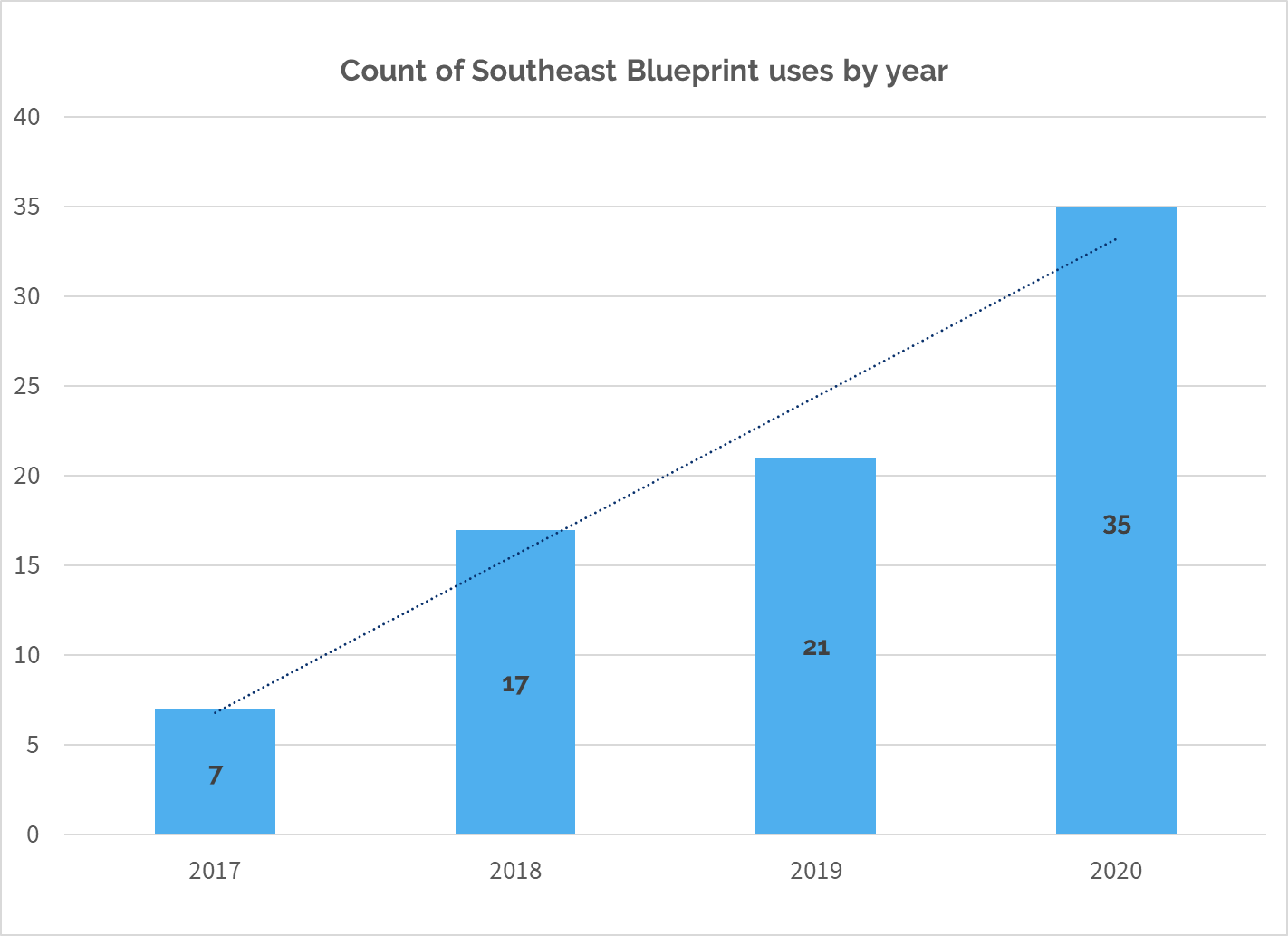2020 - This year in review

2020 has been a challenging year in a lot of ways. I think it’s safe to say that most people won’t spend much time fondly reminiscing about it. It’s been the kind of year that makes me want to look forward, not back. Nevertheless, SECAS accomplished some great things in 2020, so let’s review some of the highlights!
THE PRODUCTS OF SECAS: 2020 ACCOMPLISHMENTS
Updated Southeast Blueprint: The latest version of the Southeast Conservation Blueprint was released in October. Blueprint 2020 incorporated updated data for the South Atlantic and Middle Southeast subregions, and improved integration across several input plans. For more information about the Southeast Blueprint 2020 release, visit Rua’s October blog.
Released 2nd SECAS goal report: The second Recent Trends in Southeast Ecosystems report included a new indicator for areas without invasive plants, improved water quality trends, updated data on birds and prescribed fire, and new Bird Conservation Region summaries. To refresh your memory on the latest report tracking progress toward the SECAS 10% goal, read Rua’s blog post from October.
Blueprint used in 35 projects: The Southeast Blueprint was used in 35 completed projects this year, with many more still in progress. The chart at the beginning of this blog shows how use of the Blueprint has steadily increased over time. We’re excited to build on this momentum in 2021! Here are a few examples of how the Blueprint was used this year:
- The Catawba Council of Government (COG) used the Blueprint to help identify natural resource priorities in the comprehensive plan for the Town of Van Wyck in upstate South Carolina. This is the 4th local plan in upstate South Carolina to incorporate the Blueprint, continuing a strong collaboration with the Catawba COG over the last several years. While these plans are still awaiting approval by local elected officials, we’re excited about the Blueprint’s growing role in helping inform city and county planning.
- The Blueprint was used to strengthen 21 proposals for funding this year, an all-time high! 20 people from 14 different organizations used the Blueprint to help support their grant applications in 2020. For most of those proposals, we’ll have to wait until next year to find out if they were successfully funded. The Blueprint was also used to review some proposals and to help evaluate parcels to determine whether they should be a priority for pursuing funding.
- Through a Federal Emergency Management Agency (FEMA) project, six Florida coastal communities are working to rebuild and improve resilience in the wake of extensive storm damage. The Blueprint helped identify important habitat corridors and show linkages to natural resource assets as part of a vision for strengthening green infrastructure and a regional recreation-based economy. SECAS has also offered to help those cities use the Blueprint to bring in resources to implement that vision and clear barriers to conservation action. To learn more about this story, read Louise’s blog from September as well as her post from last month.
Furthered research on the impacts of climate change on prescribed fire: Through the Vital Futures project, the Southeast Climate Adaptation Science Center has made an invaluable contribution to SECAS by assessing the implications of climate change and other drivers of landscape change on conservation goals. In 2020, research from this project was published in The International Journal of Wildland Fire. This work led by Dr. John Kupfer and Dr. Adam Terando used projections from Global Climate Models to explore the potential effects of climate change on prescribed fire management in the southeastern U.S. The results predict that climate change is likely to cause substantial reductions in available burning days during late spring and summer months, which would restrict burn window opportunities to cool season months in many parts of the region. To learn more about this project, visit the project page on the Southeast CASC website. You can also read the open access journal article.
THE SECAS PARTNERSHIP: 2020 ACCOMPLISHMENTS
Added nonprofit representation: Back in January, SECAS added new Points of Contact (POCs) representing nonprofit organizations, increasing the diversity of input and perspective in the POC group. The SECAS Steering Committee welcomed representatives of the Southern Group of State Foresters, The Nature Conservancy, and the Open Space Institute. To read more about the new POCs, check out Mallory’s blog post.
Started the SECAS Futures project: This year, SECAS began a research project to examine its governance structures and assess how the initiative is adding value to partner organizations. The results are being presented to the SECAS Steering Committee this week. The final report and a webinar exploring the project’s findings will be forthcoming in early 2021. To refresh your memory on the SECAS Futures project, check out Mallory’s blog from January as well as this July post from graduate research assistant Kathryn Jewell.
Jointly hosted webinar series with SE CASC: From April through July, SECAS collaborated with the Southeast Climate Adaptation Science Center (CASC) on a webinar series highlighting Southeast CASC projects that apply to landscape-scale conservation in the Southeast. To see the descriptions of each webinar and watch the recorded presentations, visit the series webpage.
Held symposium at SEAFWA conference: At the Southeastern Association of Fish and Wildlife Agencies (SEAFWA) virtual annual meeting in October, SECAS hosted a symposium entitled “SECAS: Recent Progress – Future Directions” attended by over 140 people. To read an overview of the symposium, see Mallory’s blog post from October.
Hired new Blueprint improvement and user support staff: The U.S. Fish and Wildlife Service hired three new staff this year as a contribution to SECAS: Emily Granstaff, Chris DeVore, and Daniel Adams. This new user support and improvement team is based in Cookeville, TN and will work primarily on improving the Blueprint and supporting Blueprint users in the Appalachian and Middle Southeast subregions.